Utilizing Deep Learning and Spatial Analysis for Accurate Forest Fire Occurrence Forecasting in the Central Region of China
Abstract
:1. Introduction
2. Resources and Methods
2.1. Study Area
2.2. Data Sources
2.3. Method
2.3.1. Kernel Density Estimation (KDE)
2.3.2. Spatial Autocorrelation Analysis
2.3.3. Convolutional Neural Network (CNN)
2.3.4. Evaluation Indicators
3. Results
3.1. The Results of Kernel Density Estimations
3.2. Results of Autocorrelation Analysis on Forest Fire Occurrences in Central China Region
3.3. Evaluation of Forecast Precision for Forest Fires in Central China
3.4. Predicting Season Forest Fires in the Central China
- (i)
- Spring: During this season, specific regions in Hunan Province (Hengyang, Loudi, Yongzhou) and Hubei Province (Huangshi, Xianning) experience significantly elevated forest fire risks. The combination of rising temperatures, dry conditions with minimal rainfall, and accumulated dead vegetation from winter creates ideal fuel conditions. Agricultural practices like burning crop residues and increased tourist activities further contribute to the heightened risk. In Heilongjiang Province (Yichun, Heihe) and Jilin Province, frequent lightning strikes and geographical features such as steep mountains and dense vegetation also increase the likelihood of fires.
- (ii)
- Summer: The onset of the rainy season generally reduces forest fire risks across most areas in the southern part of Central China due to increased humidity. However, regions like Huangshi in Hubei Province and parts of Heilongjiang Province (Yichun, Heihe) may still face higher risks due to uneven rainfall distribution or localized drought conditions.
- (iii)
- Autumn: Forest fire risks increase again in autumn, particularly in places such as Binzhou, Yongzhou, and Hengyang in Hunan Province. As temperatures decrease and humidity levels drop, fallen leaves provide additional fuel for fires. Agricultural activities during the harvest season and increased tourism further elevate the risk during this period.
- (iv)
- Winter: Despite colder temperatures, winter poses significant fire risks in regions such as Hengyang, Chenzhou, and Yongzhou in Hunan Province, as well as Huangshi in Hubei Province. Dry climates and low humidity contribute to the risk, exacerbated by dry vegetation and accumulated combustible materials. Human activities such as land clearing for agriculture also increase the likelihood of fires during winter.
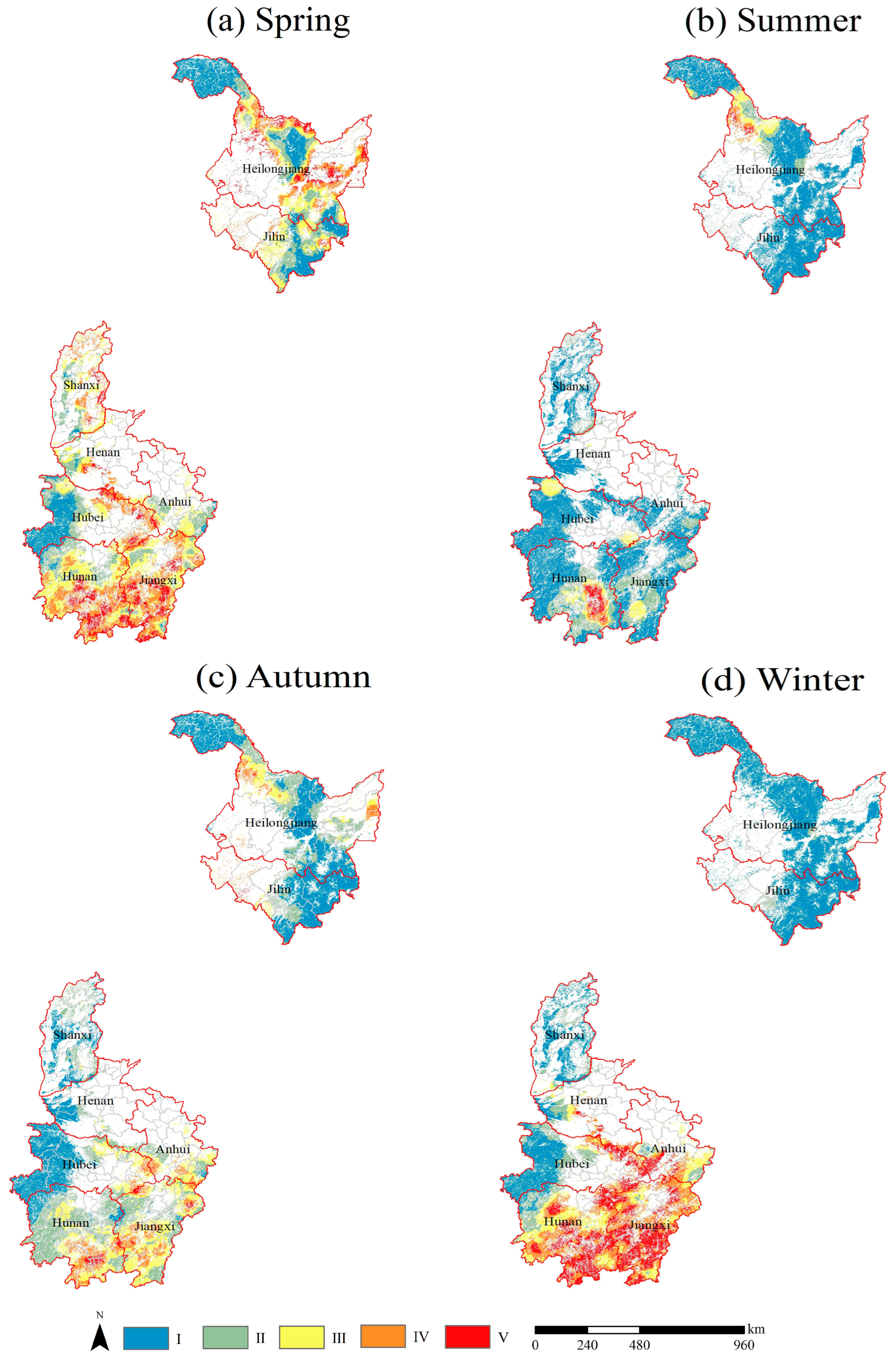
4. Discussion and Conclusions
4.1. Discussion
4.2. Conclusions
Author Contributions
Funding
Data Availability Statement
Acknowledgments
Conflicts of Interest
Appendix A
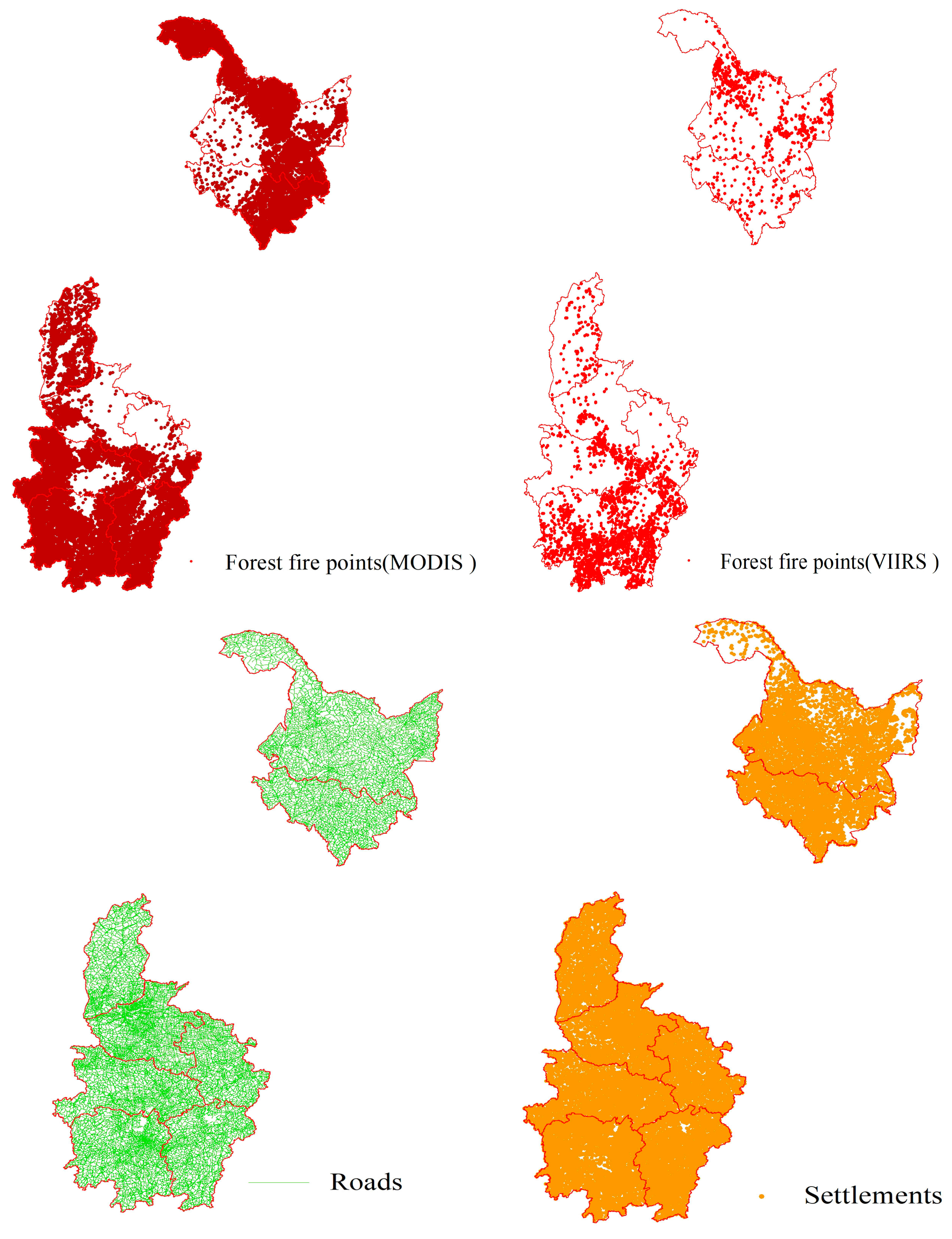
Appendix B
| Convolutional Neural Network (CNN) Pseudocode Demonstration: Forest Fire Occurrence Prediction |
| import numpy as np import tensorflow as tf from tensorflow.keras.models import Sequential from tensorflow.keras.layers import Conv2D, MaxPooling2D, Flatten, Dense, Dropout, BatchNormalization, LeakyReLU from tensorflow.keras.optimizers import SGD from sklearn.metrics import accuracy_score, precision_score, recall_score, f1_score, roc_auc_score from sklearn.model_selection import train_test_split # Assuming you have a function to load your dataset def load_dataset(): # Replace with your actual data loading and preprocessing steps X, y = load_data() # Example function to load data X_train, X_test, y_train, y_test = train_test_split(X, y, test_size = 0.2, random_state = 42) X_train, X_val, y_train, y_val = train_test_split(X_train, y_train, test_size = 0.2, random_state = 42) return X_train, X_val, X_test, y_train, y_val, y_test # Step 1: Define the CNN model def create_cnn_model(input_shape, num_classes): model = Sequential() # Convolutional layers model.add(Conv2D(64, (3, 3), activation = ‘relu’, input_shape = input_shape)) model.add(MaxPooling2D((2, 2))) model.add(Conv2D(128, (3, 3), activation = ‘relu’)) model.add(MaxPooling2D((2, 2))) model.add(Conv2D(256, (3, 3), activation = ‘relu’)) model.add(MaxPooling2D((2, 2))) model.add(Flatten()) # Fully connected layers model.add(Dense(128, activation = ‘relu’)) model.add(Dropout(0.5)) # Output layer model.add(Dense(num_classes, activation = ‘sigmoid’)) # Assuming binary classification # Compile the model optimizer = SGD(learning_rate = 0.001, momentum = 0.9, decay = 0.01) model.compile(optimizer = optimizer, loss = ‘binary_crossentropy’, metrics = [‘accuracy’]) return model # Step 2: Load and preprocess the dataset X_train, X_val, X_test, y_train, y_val, y_test = load_dataset() # Step 3: Create an instance of the CNN model input_shape = X_train [0].shape # Example: (height, width, channels) num_classes = 1 # Binary classification: fire or no fire cnn_model = create_cnn_model(input_shape, num_classes) # Step 4: Train the model cnn_model.fit(X_train, y_train, epochs = 10, batch_size = 32, validation_data = (X_val, y_val)) # Step 5: Evaluate the model’s performance on the test set y_pred = cnn_model.predict(X_test) y_pred_binary = (y_pred > 0.5).astype(int) # Convert probabilities to binary predictions accuracy = accuracy_score(y_test, y_pred_binary) precision = precision_score(y_test, y_pred_binary) recall = recall_score(y_test, y_pred_binary) f1 = f1_score(y_test, y_pred_binary) auc = roc_auc_score(y_test, y_pred) # Print evaluation metrics print(f’Test Accuracy: {accuracy:.4f}’) print(f’Precision: {precision:.4f}’) print(f’Recall: {recall:.4f}’) print(f’F1 Score: {f1:.4f}’) print(f’AUC: {auc:.4f}’) |
References
- Friess, D.A.; Rogers, K.; Lovelock, C.E.; Krauss, K.W.; Hamilton, S.E.; Lee, S.Y.; Lucas, R.; Primavera, J.; Rajkaran, A.; Shi, S. The state of the world’s mangrove forests: Past, present, and future. Annu. Rev. Environ. Resour. 2019, 44, 89–115. [Google Scholar] [CrossRef]
- Lewis, S.L.; Wheeler, C.E.; Mitchard, E.T.; Koch, A. Restoring natural forests is the best way to remove atmospheric carbon. Nature 2019, 568, 25–28. [Google Scholar] [CrossRef] [PubMed]
- Mori, A.S.; Lertzman, K.P.; Gustafsson, L. Biodiversity and ecosystem services in forest ecosystems: A research agenda for applied forest ecology. J. Appl. Ecol. 2017, 54, 12–27. [Google Scholar] [CrossRef]
- Ahammad, R.; Stacey, N.; Sunderland, T.C. Use and perceived importance of forest ecosystem services in rural livelihoods of Chittagong Hill Tracts, Bangladesh. Ecosyst. Serv. 2019, 35, 87–98. [Google Scholar] [CrossRef]
- He, T.; Lamont, B.B.; Pausas, J.G. Fire as a key driver of Earth’s biodiversity. Biol. Rev. 2019, 94, 1983–2010. [Google Scholar] [CrossRef]
- Cansler, C.A.; Kane, V.R.; Hessburg, P.F.; Kane, J.T.; Jeronimo, S.M.; Lutz, J.A.; Povak, N.A.; Churchill, D.J.; Larson, A.J. Previous wildfires and management treatments moderate subsequent fire severity. For. Ecol. Manag. 2022, 504, 119764. [Google Scholar] [CrossRef]
- Wang, H.; Jin, B.; Zhang, K.; Aktar, S.; Song, Z. Effectiveness in mitigating forest fire ignition sources: A statistical study based on fire occurrence data in China. Fire 2022, 5, 215. [Google Scholar] [CrossRef]
- Pang, Y.; Li, Y.; Feng, Z.; Feng, Z.; Zhao, Z.; Chen, S.; Zhang, H. Forest fire occurrence prediction in China based on machine learning methods. Remote Sens. 2022, 14, 5546. [Google Scholar] [CrossRef]
- Wu, X.; Zhang, G.; Yang, Z.; Tan, S.; Yang, Y.; Pang, Z. Machine learning for predicting forest fire occurrence in Changsha: An innovative investigation into the introduction of a forest fuel factor. Remote Sens. 2023, 15, 4208. [Google Scholar] [CrossRef]
- Briones-Herrera, C.I.; Vega-Nieva, D.J.; Monjarás-Vega, N.A.; Flores-Medina, F.; Lopez-Serrano, P.M.; Corral-Rivas, J.J.; Carrillo-Parra, A.; Pulgarin-Gámiz, M.Á.; Alvarado-Celestino, E.; González-Cabán, A. Modeling and mapping forest fire occurrence from aboveground carbon density in Mexico. Forests 2019, 10, 402. [Google Scholar] [CrossRef]
- Cansler, C.A.; McKenzie, D. Climate, fire size, and biophysical setting control fire severity and spatial pattern in the northern Cascade Range, USA. Ecol. Appl. 2014, 24, 1037–1056. [Google Scholar] [CrossRef]
- Wotton, B.M.; Nock, C.A.; Flannigan, M.D. Forest fire occurrence and climate change in Canada. Int. J. Wildland Fire 2010, 19, 253–271. [Google Scholar] [CrossRef]
- Zhang, G.; Wang, M.; Liu, K. Forest fire susceptibility modeling using a convolutional neural network for Yunnan province of China. Int. J. Disaster Risk Sci. 2019, 10, 386–403. [Google Scholar] [CrossRef]
- Gale, M.G.; Cary, G.J.; Van Dijk, A.I.; Yebra, M. Forest fire fuel through the lens of remote sensing: Review of approaches, challenges and future directions in the remote sensing of biotic determinants of fire behaviour. Remote Sens. Environ. 2021, 255, 112282. [Google Scholar] [CrossRef]
- Hong, H.; Tsangaratos, P.; Ilia, I.; Liu, J.; Zhu, A.-X.; Xu, C. Applying genetic algorithms to set the optimal combination of forest fire related variables and model forest fire susceptibility based on data mining models. The case of Dayu County, China. Sci. Total Environ. 2018, 630, 1044–1056. [Google Scholar] [CrossRef] [PubMed]
- Ying, L.; Han, J.; Du, Y.; Shen, Z. Forest fire characteristics in China: Spatial patterns and determinants with thresholds. For. Ecol. Manag. 2018, 424, 345–354. [Google Scholar] [CrossRef]
- Moayedi, H.; Mehrabi, M.; Bui, D.T.; Pradhan, B.; Foong, L.K. Fuzzy-metaheuristic ensembles for spatial assessment of forest fire susceptibility. J. Environ. Manag. 2020, 260, 109867. [Google Scholar] [CrossRef] [PubMed]
- Shao, Y.; Wang, Z.; Feng, Z.; Sun, L.; Yang, X.; Zheng, J.; Ma, T. Assessment of China’s forest fire occurrence with deep learning, geographic information and multisource data. J. For. Res. 2023, 34, 963–976. [Google Scholar] [CrossRef]
- Du, Q.; Zhang, G.; Song, B.; Hu, X.; Yin, J. Study on Forest Fire Prediction Model. J. Subtrop. Resour. Environ. 2023, 18, 87–93. [Google Scholar]
- Gao, C.; Lin, H.-L.; Hu, H.-Q.; Song, H. A review of models of forest fire occurrence prediction in China. Chin. J. Appl. Ecol. 2020, 31, 3227–3240. [Google Scholar]
- Vogiatzoglou, K.; Papadimitriou, C.; Ampountolas, K.; Chatzimanolakis, M.; Koumoutsakos, P.; Bontozoglou, V. An interpretable wildfire spreading model for real-time predictions. arXiv 2023, arXiv:2306.01766. [Google Scholar]
- Ntinopoulos, N.; Spiliotopoulos, M.; Vasiliades, L.; Mylopoulos, N. Contribution to the study of forest fires in semi-arid regions with the use of Canadian fire weather index application in Greece. Climate 2022, 10, 143. [Google Scholar] [CrossRef]
- Shokouhi, M.; Asadi Oskouei, E.; Sadeghi, H.; Rahnama, M. Calibration and evaluation of the Forest Fire Weather Index (FWI) in the Hamoun wetland area. J. Nat. Environ. Hazards 2024, 13, 45–60. [Google Scholar]
- Masinda, M.M.; Li, F.; Qi, L.; Sun, L.; Hu, T. Forest fire risk estimation in a typical temperate forest in Northeastern China using the Canadian forest fire weather index: Case study in autumn 2019 and 2020. Nat. Hazards 2022, 111, 1085–1101. [Google Scholar] [CrossRef]
- Di Giuseppe, F.; Vitolo, C.; Krzeminski, B.; Barnard, C.; Maciel, P.; San-Miguel, J. Fire Weather Index: The skill provided by the European Centre for Medium-Range Weather Forecasts ensemble prediction system. Nat. Hazards Earth Syst. Sci. 2020, 20, 2365–2378. [Google Scholar] [CrossRef]
- Simeoni, A.; Salinesi, P.; Morandini, F. Physical modelling of forest fire spreading through heterogeneous fuel beds. Int. J. Wildland Fire 2011, 20, 625–632. [Google Scholar] [CrossRef]
- Morvan, D.; Accary, G.; Meradji, S.; Frangieh, N.; Bessonov, O. A 3D physical model to study the behavior of vegetation fires at laboratory scale. Fire Saf. J. 2018, 101, 39–52. [Google Scholar] [CrossRef]
- Prieto Herráez, D.; Asensio Sevilla, M.I.; Ferragut Canals, L.; Cascón Barbero, J.M.; Morillo Rodríguez, A. A GIS-based fire spread simulator integrating a simplified physical wildland fire model and a wind field model. Int. J. Geogr. Inf. Sci. 2017, 31, 2142–2163. [Google Scholar] [CrossRef]
- Mueller, E.V.; Skowronski, N.S.; Clark, K.L.; Gallagher, M.R.; Mell, W.E.; Simeoni, A.; Hadden, R.M. Detailed physical modeling of wildland fire dynamics at field scale—An experimentally informed evaluation. Fire Saf. J. 2021, 120, 103051. [Google Scholar] [CrossRef]
- Pimont, F.; Fargeon, H.; Opitz, T.; Ruffault, J.; Barbero, R.; Martin-StPaul, N.; Rigolot, E.; RiviÉre, M.; Dupuy, J.L. Prediction of regional wildfire activity in the probabilistic Bayesian framework of Firelihood. Ecol. Appl. 2021, 31, e02316. [Google Scholar] [CrossRef]
- Zhang, F.; Zhang, B.; Luo, J.; Liu, H.; Deng, Q.; Wang, L.; Zuo, Z. Forest fire driving factors and fire risk zoning based on an optimal parameter logistic regression model: A case study of the Liangshan Yi Autonomous Prefecture, China. Fire 2023, 6, 336. [Google Scholar] [CrossRef]
- Su, Z.; Zheng, L.; Luo, S.; Tigabu, M.; Guo, F. Modeling wildfire drivers in Chinese tropical forest ecosystems using global logistic regression and geographically weighted logistic regression. Nat. Hazards 2021, 108, 1317–1345. [Google Scholar] [CrossRef]
- Cao, Q.; Zhang, L.; Su, Z.; Wang, G.; Sun, S.; Guo, F. Comparing four regression techniques to explore factors governing the number of forest fires in Southeast, China. Geomat. Nat. Hazards Risk 2021, 12, 499–521. [Google Scholar] [CrossRef]
- Graff, C.A.; Coffield, S.R.; Chen, Y.; Foufoula-Georgiou, E.; Randerson, J.T.; Smyth, P. Forecasting daily wildfire activity using poisson regression. IEEE Trans. Geosci. Remote Sens. 2020, 58, 4837–4851. [Google Scholar] [CrossRef]
- Tien Bui, D.; Le, K.-T.T.; Nguyen, V.C.; Le, H.D.; Revhaug, I. Tropical forest fire susceptibility mapping at the Cat Ba National Park Area, Hai Phong City, Vietnam, using GIS-based kernel logistic regression. Remote Sens. 2016, 8, 347. [Google Scholar] [CrossRef]
- Mohajane, M.; Costache, R.; Karimi, F.; Pham, Q.B.; Essahlaoui, A.; Nguyen, H.; Laneve, G.; Oudija, F. Application of remote sensing and machine learning algorithms for forest fire mapping in a Mediterranean area. Ecol. Indic. 2021, 129, 107869. [Google Scholar] [CrossRef]
- Latifah, A.L.; Shabrina, A.; Wahyuni, I.N.; Sadikin, R. Evaluation of Random Forest model for forest fire prediction based on climatology over Borneo. In Proceedings of the 2019 International Conference on Computer, Control, Informatics and Its Applications (IC3INA), Tangerang, Indonesia, 23–24 October 2019; pp. 4–8. [Google Scholar]
- Su, Z.; Hu, H.; Wang, G.; Ma, Y.; Yang, X.; Guo, F. Using GIS and Random Forests to identify fire drivers in a forest city, Yichun, China. Geomat. Nat. Hazards Risk 2018, 9, 1207–1229. [Google Scholar] [CrossRef]
- Pham, B.T.; Jaafari, A.; Avand, M.; Al-Ansari, N.; Dinh Du, T.; Yen, H.P.H.; Phong, T.V.; Nguyen, D.H.; Le, H.V.; Mafi-Gholami, D. Performance evaluation of machine learning methods for forest fire modeling and prediction. Symmetry 2020, 12, 1022. [Google Scholar] [CrossRef]
- Abid, F. A survey of machine learning algorithms based forest fires prediction and detection systems. Fire Technol. 2021, 57, 559–590. [Google Scholar] [CrossRef]
- Ran, C.; Fang, L. Prediction model of forest fire area based on the improved Extreme Gradient Boosting. In Proceedings of the 2021 2nd International Conference on Computer Communication and Network Security (CCNS), Xining, China, 30 July–1 August 2021; pp. 16–19. [Google Scholar]
- Alzubaidi, L.; Zhang, J.; Humaidi, A.J.; Al-Dujaili, A.; Duan, Y.; Al-Shamma, O.; Santamaría, J.; Fadhel, M.A.; Al-Amidie, M.; Farhan, L. Review of deep learning: Concepts, CNN architectures, challenges, applications, future directions. J. Big Data 2021, 8, 53. [Google Scholar] [CrossRef]
- Kattenborn, T.; Leitloff, J.; Schiefer, F.; Hinz, S. Review on Convolutional Neural Networks (CNN) in vegetation remote sensing. ISPRS J. Photogramm. Remote Sens. 2021, 173, 24–49. [Google Scholar] [CrossRef]
- Zarándy, Á.; Rekeczky, C.; Szolgay, P.; Chua, L.O. Overview of CNN research: 25 years history and the current trends. In Proceedings of the 2015 IEEE International Symposium on Circuits and Systems (ISCAS), Lisbon, Portugal, 24–27 May 2015; pp. 401–404. [Google Scholar]
- Zheng, S.; Gao, P.; Wang, W.; Zou, X. A highly accurate forest fire prediction model based on an improved dynamic convolutional neural network. Appl. Sci. 2022, 12, 6721. [Google Scholar] [CrossRef]
- Bhatt, S.; Chouhan, U. An enhanced method for predicting and analysing forest fires using an attention-based CNN model. J. For. Res. 2024, 35, 67. [Google Scholar] [CrossRef]
- Duc, H.A.; Phuong, N.T.H. Harnessing deep learning for wildfire risks prediction: A novel approach. Int. J. Adv. Res. Comput. Sci. 2023, 14, 46–50. [Google Scholar] [CrossRef]
- Ghali, R.; Akhloufi, M.A. Deep learning approaches for wildland fires using satellite remote sensing data: Detection, mapping, and prediction. Fire 2023, 6, 192. [Google Scholar] [CrossRef]
- van Wees, D.; van Der Werf, G.R.; Randerson, J.T.; Andela, N.; Chen, Y.; Morton, D.C. The role of fire in global forest loss dynamics. Glob. Chang. Biol. 2021, 27, 2377–2391. [Google Scholar] [CrossRef]
- Wang, L.; Zheng, L. Research on Industrial Superiority of China’s Central Cities-Take 35 Large Cities in China as an Example. In Proceedings of the 2018 2nd International Conference on Management, Education and Social Science (ICMESS 2018), Qingdao, China, 23–24 June 2018; pp. 753–758. [Google Scholar]
- Qin, D.; Tao, S.; Dong, S.; Luo, Y. Climate, environmental, and socioeconomic characteristics of China. In Climate Environmental Change in China; Springer: Berlin/Heidelberg, Germany, 2016; pp. 1–27. [Google Scholar]
- Zhang, G.; Ding, Z.; Wang, F. A study on spatial-temporal variation of economic density of central China. Econ. Geogr. 2013, 33, 15–23. [Google Scholar]
- Huesca, M.; Litago, J.; Palacios-Orueta, A.; Montes, F.; Sebastián-López, A.; Escribano, P. Assessment of forest fire seasonality using MODIS fire potential: A time series approach. Agric. For. Meteorol. 2009, 149, 1946–1955. [Google Scholar] [CrossRef]
- Tian, L.; Wang, J.; Zhou, H.; Wang, J. Automatic detection of forest fire disturbance based on dynamic modelling from MODIS time-series observations. Int. J. Remote Sens. 2018, 39, 3801–3815. [Google Scholar] [CrossRef]
- Albar, I.; Jaya, I.N.S.; Saharjo, B.H.; Kuncahyo, B.; Vadrevu, K.P. Spatio-temporal analysis of land and forest fires in Indonesia using MODIS active fire dataset. In Land-Atmospheric Research Applications in South Southeast Asia; Springer: Cham, Switzerland, 2018; pp. 105–127. [Google Scholar]
- Cheng, D.; Rogan, J.; Schneider, L.; Cochrane, M. Evaluating MODIS active fire products in subtropical Yucatán forest. Remote Sens. Lett. 2013, 4, 455–464. [Google Scholar] [CrossRef]
- Schroeder, W.; Oliva, P.; Giglio, L.; Csiszar, I.A. The New VIIRS 375 m active fire detection data product: Algorithm description and initial assessment. Remote Sens. Environ. 2014, 143, 85–96. [Google Scholar] [CrossRef]
- Coskuner, K.A. Assessing the performance of MODIS and VIIRS active fire products in the monitoring of wildfires: A case study in Turkey. IForest-Biogeosciences For. 2022, 15, 85. [Google Scholar] [CrossRef]
- Liu, J.; Kuang, W.; Zhang, Z.; Xu, X.; Qin, Y.; Ning, J.; Zhou, W.; Zhang, S.; Li, R.; Yan, C. Spatiotemporal characteristics, patterns, and causes of land-use changes in China since the late 1980s. J. Geogr. Sci. 2014, 24, 195–210. [Google Scholar] [CrossRef]
- Liu, J.; Zhang, Z.; Xu, X.; Kuang, W.; Zhou, W.; Zhang, S.; Li, R.; Yan, C.; Yu, D.; Wu, S. Spatial patterns and driving forces of land use change in China during the early 21st century. J. Geogr. Sci. 2010, 20, 483–494. [Google Scholar] [CrossRef]
- Wu, Z.; He, H.S.; Keane, R.E.; Zhu, Z.; Wang, Y.; Shan, Y. Current and future patterns of forest fire occurrence in China. Int. J. Wildland Fire 2019, 29, 104–119. [Google Scholar] [CrossRef]
- Naderpour, M.; Rizeei, H.M.; Ramezani, F. Forest fire risk prediction: A spatial deep neural network-based framework. Remote Sens. 2021, 13, 2513. [Google Scholar] [CrossRef]
- Ciesielski, M.; Balazy, R.; Borkowski, B.; Szczesny, W.; Zasada, M.; Kaczmarowski, J.; Kwiatkowski, M.; Szczygiel, R.; Milanovic, S. Contribution of anthropogenic, vegetation, and topographic features to forest fire occurrence in Poland. iForest-Biogeosciences For. 2022, 15, 307. [Google Scholar] [CrossRef]
- Ahmad, F.; Goparaju, L.; Qayum, A. Himalayan forest fire characterization in relation to topography, socio-economy and meteorology parameters in Arunachal Pradesh, India. Spat. Inf. Res. 2018, 26, 305–315. [Google Scholar] [CrossRef]
- Flannigan, M.; Stocks, B.; Turetsky, M.; Wotton, M. Impacts of climate change on fire activity and fire management in the circumboreal forest. Glob. Chang. Biol. 2009, 15, 549–560. [Google Scholar] [CrossRef]
- Abram, N.J.; Henley, B.J.; Sen Gupta, A.; Lippmann, T.J.; Clarke, H.; Dowdy, A.J.; Sharples, J.J.; Nolan, R.H.; Zhang, T.; Wooster, M.J. Connections of climate change and variability to large and extreme forest fires in southeast Australia. Commun. Earth Environ. 2021, 2, 8. [Google Scholar] [CrossRef]
- Chéret, V.; Denux, J.-P. Analysis of MODIS NDVI time series to calculate indicators of Mediterranean forest fire susceptibility. GIScience Remote Sens. 2011, 48, 171–194. [Google Scholar] [CrossRef]
- Gabban, A.; San-Miguel-Ayanz, J.; Viegas, D. On the suitability of the use of normalized difference vegetation index for forest fire risk assessment. Int. J. Remote Sens. 2006, 27, 5095–5102. [Google Scholar] [CrossRef]
- Shao, Y.; Fan, G.; Feng, Z.; Sun, L.; Yang, X.; Ma, T.; Li, X.; Fu, H.; Wang, A. Prediction of forest fire occurrence in China under climate change scenarios. J. For. Res. 2023, 34, 1217–1228. [Google Scholar] [CrossRef]
- Kim, S.J.; Lim, C.-H.; Kim, G.S.; Lee, J.; Geiger, T.; Rahmati, O.; Son, Y.; Lee, W.-K. Multi-temporal analysis of forest fire probability using socio-economic and environmental variables. Remote Sens. 2019, 11, 86. [Google Scholar] [CrossRef]
- Kamalov, F. Kernel density estimation based sampling for imbalanced class distribution. Inf. Sci. 2020, 512, 1192–1201. [Google Scholar] [CrossRef]
- Gramacki, A. Nonparametric Kernel Density Estimation and Its Computational Aspects; Springer: Berlin/Heidelberg, Germany, 2018; Volume 37. [Google Scholar]
- Monjarás-Vega, N.A.; Briones-Herrera, C.I.; Vega-Nieva, D.J.; Calleros-Flores, E.; Corral-Rivas, J.J.; López-Serrano, P.M.; Pompa-García, M.; Rodríguez-Trejo, D.A.; Carrillo-Parra, A.; González-Cabán, A. Predicting forest fire kernel density at multiple scales with geographically weighted regression in Mexico. Sci. Total Environ. 2020, 718, 137313. [Google Scholar] [CrossRef]
- Lee, W.J.; Mendis, G.P.; Triebe, M.J.; Sutherland, J.W. Monitoring of a machining process using kernel principal component analysis and kernel density estimation. J. Intell. Manuf. 2020, 31, 1175–1189. [Google Scholar] [CrossRef]
- Liu, Z.; Ge, C.; Zheng, K.; Bao, S.; Cui, Y.; Yuan, Y.; Zhang, Y. Forecasting Daily PM2. 5 Concentrations in Wuhan with a Spatial-Autocorrelation-based Long Short-Term Memory Model. Atmos. Environ. 2024, 331, 120605. [Google Scholar] [CrossRef]
- Wen, L.; Li, B.; Peng, Y.; Zhou, Y.; Weng, A.; Jin, Y.; Cai, G.; Lin, Y.; Chen, B. Exploring the evolution of coupled natural-cultural ecosystem services and their geographically scaled driven modeling in a coastal city of Southeast China. J. Environ. Manag. 2024, 361, 121265. [Google Scholar] [CrossRef]
- He, Q.; Chen, C.; Wang, Y.; Sun, Y.; Liu, Y.; Hu, B. Fusion Method for Multi-Source Remote Sensing Daily Precipitation Data: Random Forest Model Considering Spatial Autocorrelation. J. Geo-Inf. Sci. 2024, 26, 1517–1530. [Google Scholar]
- Yang, J.; Liu, Q.; Deng, M. Spatial hotspot detection in the presence of global spatial autocorrelation. Int. J. Geogr. Inf. Sci. 2023, 37, 1787–1817. [Google Scholar] [CrossRef]
- Li, Z.; Wang, R.; Shen, X. Cultivated Land Protection Zoning Based on Quality Index and Spatial Autocorrelation. Chin. J. Soil Sci. 2021, 52, 785–792. [Google Scholar]
- Li, Z.; Liu, F.; Yang, W.; Peng, S.; Zhou, J. A survey of convolutional neural networks: Analysis, applications, and prospects. IEEE Trans. Neural Netw. Learn. Syst. 2021, 33, 6999–7019. [Google Scholar] [CrossRef]
- Gu, J.; Wang, Z.; Kuen, J.; Ma, L.; Shahroudy, A.; Shuai, B.; Liu, T.; Wang, X.; Wang, G.; Cai, J. Recent advances in convolutional neural networks. Pattern Recognit. 2018, 77, 354–377. [Google Scholar] [CrossRef]
- Ketkar, N.; Moolayil, J.; Ketkar, N.; Moolayil, J. Deep Learning with Python: Learn Best Practices of Deep Learning Models with PyTorch. In Apress LP; Springer: Berlin/Heidelberg, Germany, 2020. [Google Scholar]
- Krichen, M. Convolutional neural networks: A survey. Computers 2023, 12, 151. [Google Scholar] [CrossRef]
- Yacouby, R.; Axman, D. Probabilistic extension of precision, recall, and f1 score for more thorough evaluation of classification models. In Proceedings of the First Workshop on Evaluation and Comparison of NLP Systems, Online, 20 November 2020; pp. 79–91. [Google Scholar]
- Chicco, D.; Jurman, G. The Matthews correlation coefficient (MCC) should replace the ROC AUC as the standard metric for assessing binary classification. Biodata Min. 2023, 16, 4. [Google Scholar] [CrossRef] [PubMed]
- Ahmed, B.; Ali, G.; Hussain, A.; Baseer, A.; Ahmed, J. Analysis of text feature extractors using deep learning on fake news. Eng. Technol. Appl. Sci. Res. 2021, 11, 7001–7005. [Google Scholar] [CrossRef]
- Farfán, M.; Dominguez, C.; Espinoza, A.; Jaramillo, A.; Alcántara, C.; Maldonado, V.; Tovar, I.; Flamenco, A. Forest fire probability under ENSO conditions in a semi-arid region: A case study in Guanajuato. Environ. Monit. Assess. 2021, 193, 684. [Google Scholar] [CrossRef] [PubMed]
- Bai, M.; Wang, X.; Yao, Q.; Fang, K. ENSO modulates interaction between forest insect and fire disturbances in China. Nat. Hazards Res. 2022, 2, 138–146. [Google Scholar] [CrossRef]
- Andela, N.; Van Der Werf, G.R. Recent trends in African fires driven by cropland expansion and El Niño to La Niña transition. Nat. Clim. Chang. 2014, 4, 791–795. [Google Scholar]
- Van Der Werf, G.R.; Randerson, J.T.; Collatz, G.J.; Giglio, L.; Kasibhatla, P.S.; Arellano, A.F., Jr.; Olsen, S.C.; Kasischke, E.S. Continental-scale partitioning of fire emissions during the 1997 to 2001 El Nino/La Nina period. Science 2004, 303, 73–76. [Google Scholar] [CrossRef] [PubMed]
- Fu, Y.; Li, R.; Wang, X.; Bergeron, Y.; Valeria, O.; Chavardès, R.D.; Wang, Y.; Hu, J. Fire detection and fire radiative power in forests and low-biomass lands in Northeast Asia: MODIS versus VIIRS Fire Products. Remote Sens. 2020, 12, 2870. [Google Scholar] [CrossRef]
- Li, F.; Zhang, X.; Kondragunta, S.; Csiszar, I. Comparison of fire radiative power estimates from VIIRS and MODIS observations. J. Geophys. Res. Atmos. 2018, 123, 4545–4563. [Google Scholar] [CrossRef]
- Jiao, Q.; Fan, M.; Tao, J.; Wang, W.; Liu, D.; Wang, P. Forest fire patterns and lightning-caused forest fire detection in Heilongjiang Province of China using satellite data. Fire 2023, 6, 166. [Google Scholar] [CrossRef]
- Liu, W.; Wang, S.; Zhou, Y.; Wang, L.; Zhu, J.; Wang, F. Lightning-caused forest fire risk rating assessment based on case-based reasoning: A case study in DaXingAn Mountains of China. Nat. Hazards 2016, 81, 347–363. [Google Scholar] [CrossRef]
- Costafreda-Aumedes, S.; Comas, C.; Vega-Garcia, C. Human-caused fire occurrence modelling in perspective: A review. Int. J. Wildland Fire 2017, 26, 983–998. [Google Scholar] [CrossRef]
- Alkhatib, R.; Sahwan, W.; Alkhatieb, A.; Schütt, B. A brief review of machine learning algorithms in forest fires science. Appl. Sci. 2023, 13, 8275. [Google Scholar] [CrossRef]
- Gaikwad, A.; Bhuta, N.; Jadhav, T.; Jangale, P.; Shinde, S. A review on forest fire prediction techniques. In Proceedings of the 2022 6th International Conference On Computing, Communication, Control And Automation (ICCUBEA), Pune, India, 26–27 August 2022; pp. 1–5. [Google Scholar]
- Harvey, B.J. Human-caused climate change is now a key driver of forest fire activity in the western United States. Proc. Natl. Acad. Sci. USA 2016, 113, 11649–11650. [Google Scholar] [CrossRef]
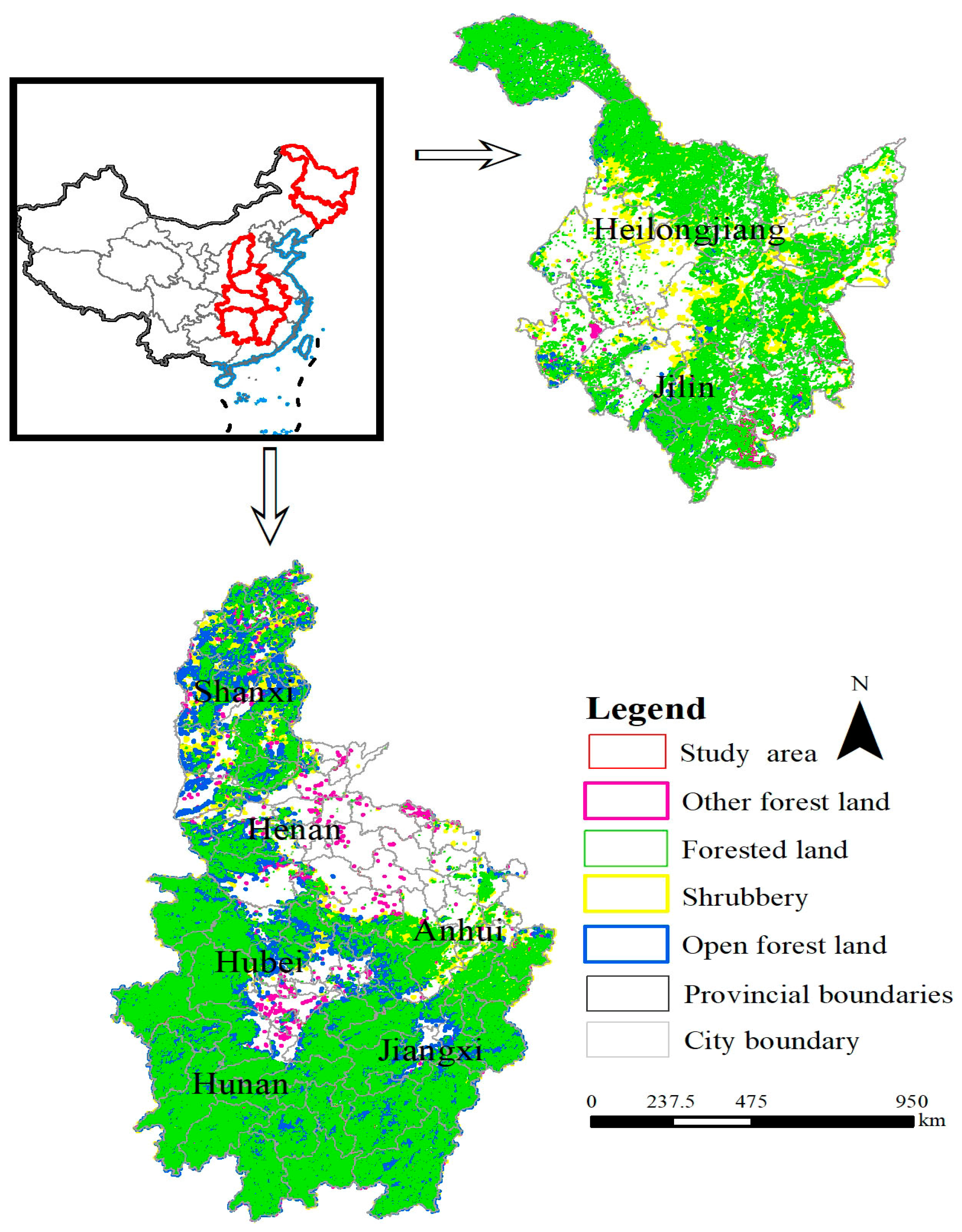





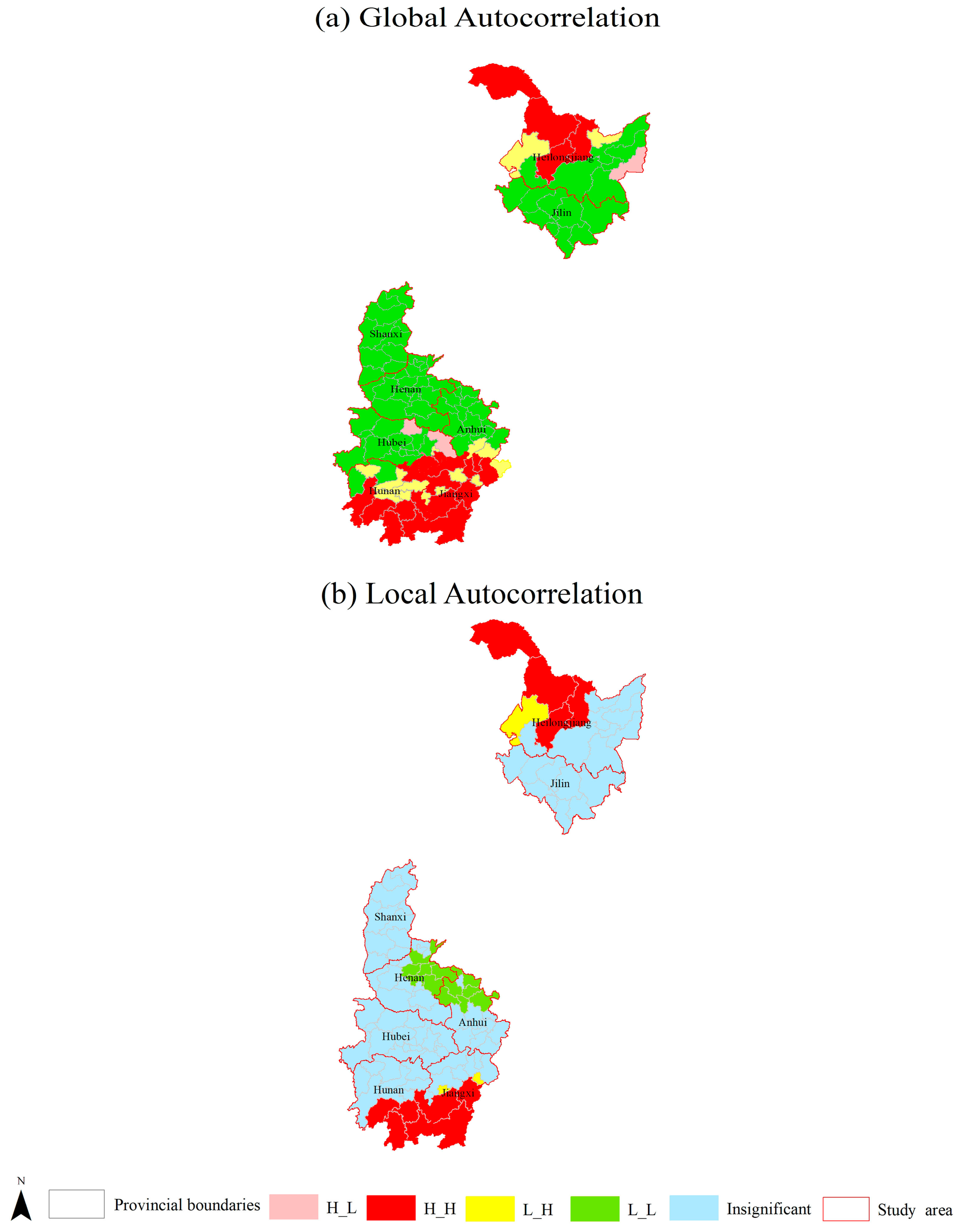
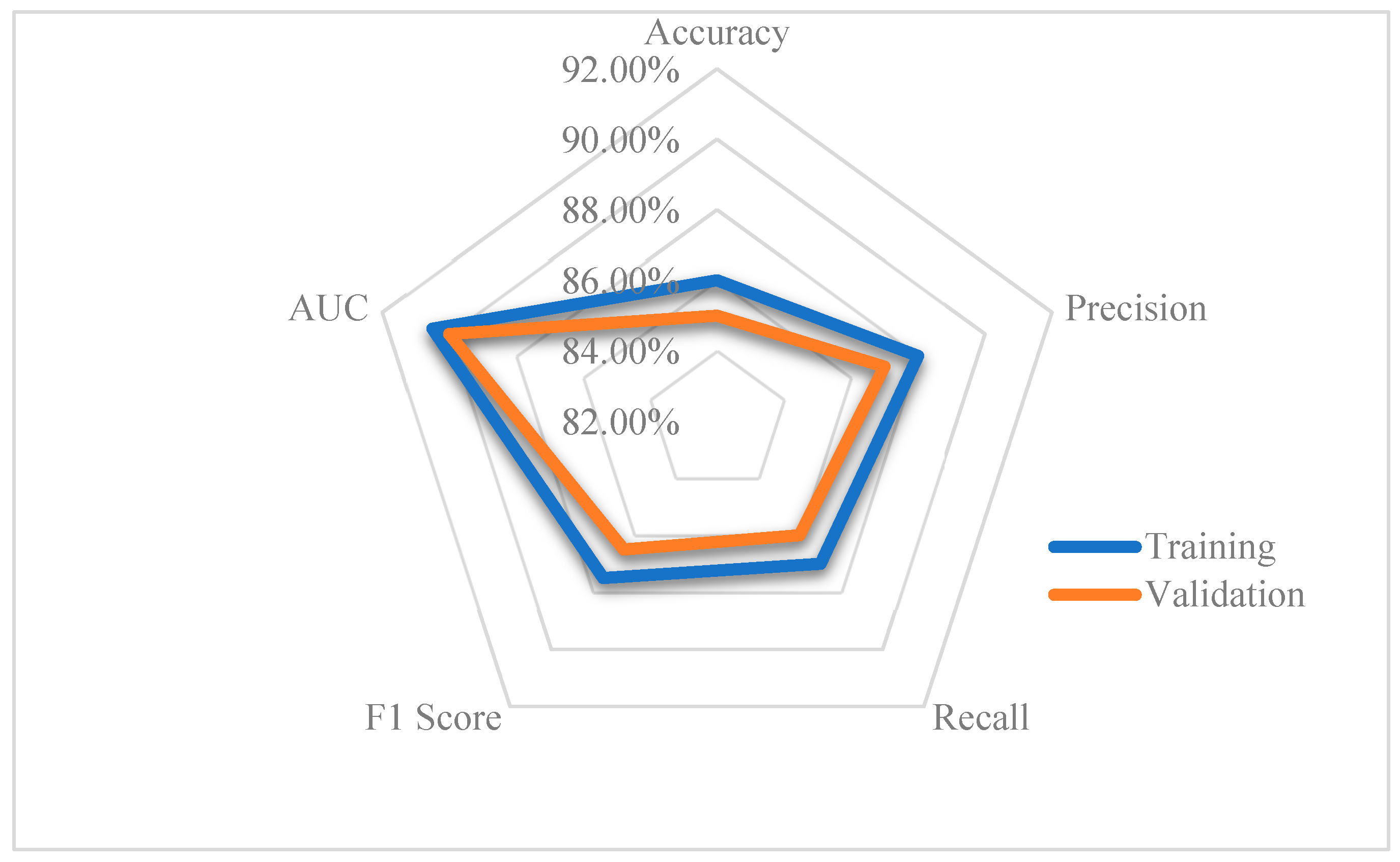
| Classification | Data | Resolution | Source | References |
|---|---|---|---|---|
| Topographic | Slope/Elevation/Slope direction | 1 km | https://www.resdc.cn (accessed on 10 August 2023) | [63,64] |
| Climate | Average daily surface temperature/average daily relative humidity/daily maximum surface temperature, etc. | - | https://data.cma.cn (accessed on 8 August 2023) | [12,65,66] |
| Vegetation | Vegetation types | - | https://www.resdc.cn (accessed on 9 September 2022) | [67,68] |
| Social and human factors | Distance from road/Distance from residential area/Gross Domestic Product/Population | 1:100,000, 1:100,000, 1 km, 1 km | https://www.resdc.cn (accessed on 12 September 2023) | [69,70] |
Disclaimer/Publisher’s Note: The statements, opinions and data contained in all publications are solely those of the individual author(s) and contributor(s) and not of MDPI and/or the editor(s). MDPI and/or the editor(s) disclaim responsibility for any injury to people or property resulting from any ideas, methods, instructions or products referred to in the content. |
© 2024 by the authors. Licensee MDPI, Basel, Switzerland. This article is an open access article distributed under the terms and conditions of the Creative Commons Attribution (CC BY) license (https://creativecommons.org/licenses/by/4.0/).
Share and Cite
Guo, Y.; Hai, Q.; Bayarsaikhan, S. Utilizing Deep Learning and Spatial Analysis for Accurate Forest Fire Occurrence Forecasting in the Central Region of China. Forests 2024, 15, 1380. https://doi.org/10.3390/f15081380
Guo Y, Hai Q, Bayarsaikhan S. Utilizing Deep Learning and Spatial Analysis for Accurate Forest Fire Occurrence Forecasting in the Central Region of China. Forests. 2024; 15(8):1380. https://doi.org/10.3390/f15081380
Chicago/Turabian StyleGuo, Youbao, Quansheng Hai, and Sainbuyan Bayarsaikhan. 2024. "Utilizing Deep Learning and Spatial Analysis for Accurate Forest Fire Occurrence Forecasting in the Central Region of China" Forests 15, no. 8: 1380. https://doi.org/10.3390/f15081380







